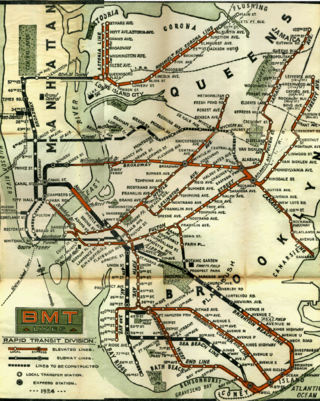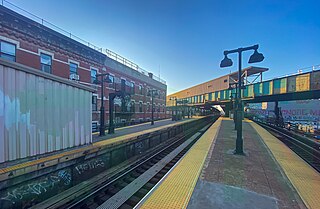
The BMT Lexington Avenue Line was the first standard elevated railway in Brooklyn, New York, operated in its later days by the Brooklyn Rapid Transit Company, the Brooklyn–Manhattan Transit Corporation, and then the City of New York.
The Myrtle Avenue Line, also called the Myrtle Avenue Elevated, is a fully elevated line of the New York City Subway as part of the BMT division. The line is the last surviving remnant of one of the original Brooklyn elevated railroads. The remnant line operates as a spur branch from the Jamaica Line to Bushwick, Ridgewood, and Middle Village, terminating at its original eastern terminal across the street from Lutheran Cemetery. Until 1969, the line continued west into Downtown Brooklyn and, until 1944, over the Brooklyn Bridge to the Park Row Terminal in Manhattan.

The Myrtle Avenue station is a New York City Subway express station on the BMT Jamaica Line. Located at the intersection of Myrtle Avenue and Broadway in Bushwick, Brooklyn. It is served by the J and M trains at all times, and by the Z during rush hours in peak direction.

The Gates Avenue station is a local station on the elevated BMT Jamaica Line of the New York City Subway, located at the intersection of Gates Avenue and Broadway at the border of Bedford–Stuyvesant and Bushwick, Brooklyn. It is served by the Z train during rush hours in the peak direction and by the J train at all other times.
The Bridge-Jay Street station was a station on the demolished BMT Myrtle Avenue Line in Brooklyn, New York City. It had 2 tracks and 1 island platform. It was opened on April 10, 1888 as Jay Street, and served Myrtle Avenue Line trains as well as the BMT Lexington Avenue Line, and until it was demolished in 1940, the BMT Fifth Avenue Line, which itself also served BMT Culver Line trains. From 1944 until its demolition in 1969, it had a free transfer to the IND Fulton Street and IND Culver lines at Jay Street – Borough Hall. Around that time, it was renamed "Bridge-Jay Street." The next stop to the north was Navy Street for trains traveling on the Lexington & Myrtle Avenue Lines, and Fulton Street other trains until its demolition in 1940. The next stop to the south was Adams Street. The station was closed on October 4, 1969, after a fire on the elevated structure.
The Navy Street station was a station on the demolished BMT Myrtle Avenue Line in Brooklyn, New York City. It had 2 tracks and 1 island platform. The station was originally built on April 10, 1888 for the Myrtle Avenue Elevated trains, but also served Lexington Avenue Elevated trains by 1891. A segment of the Lexington Avenue Line once turned north from here onto Hudson Avenue and York Street on its way to the Fulton Ferry until 1904, when Lexington and Fifth Avenue trains were redirected along Myrtle Avenue west of this station. It closed on October 4, 1969, after a fire on the elevated structure. The next stop to the north was Vanderbilt Avenue. The next stop to the south was Bridge–Jay Streets.
The Adams Street station was a station on the demolished BMT Myrtle Avenue Line and BMT Lexington Avenue Line in Brooklyn, New York City. It had 2 tracks and 2 side platforms. It was opened on February 13, 1888, as "City Hall Station" and closed on March 5, 1944. The next stop to the south was Bridge–Jay Streets. The next stop to the north was Sands Street.
The Vanderbilt Avenue station was a station on the now-demolished BMT Myrtle Avenue Line and BMT Lexington Avenue Line in Brooklyn, New York City. It had two tracks and one island platform. It closed on October 4, 1969, along with the rest of the elevated structure, after a fire. The next stop to the north was Washington Avenue, and to the south was Navy Street.
The Nostrand Avenue station was a station on the demolished section of the BMT Myrtle Avenue Line. The station was located at the intersection of Myrtle and Nostrand Avenues in Bedford-Stuyvesant, Brooklyn. The station opened in 1889, and closed in 1969.
The Tompkins Avenue station was a station on the demolished section of the BMT Myrtle Avenue Line. The station was located at the intersection of Myrtle and Tompkins Avenues in Bedford-Stuyvesant, Brooklyn. The station opened in 1889, and closed in 1969.
The Sumner Avenue station was a station on the demolished section of the BMT Myrtle Avenue Line. The station was located at the intersection of Myrtle Avenue and Sumner Avenues in Bedford-Stuyvesant, Brooklyn. The station opened in 1889, and closed in 1969.
The Myrtle Avenue station was a station on the demolished BMT Lexington Avenue Line in Brooklyn, New York City. It was opened in May 13 1885 and had two tracks and two side platforms. It was located at the intersection of Myrtle Avenue and Grand Avenue, and had connections to Myrtle Avenue Line streetcars. A segment of the Lexington Avenue Line once ran north from here and turned west on Park Avenue to Hudson Avenue and York Street on its way to the Fulton Ferry until 1891. The Myrtle Avenue Elevated was built nearby in 1888, and Lexington Avenue Lines trains began to shift onto that line southwest of this station. It closed on October 13, 1950, although the other BMT station at that location, Grand Avenue was in operation until January 21, 1953, while the rest of the line southwest of Broadway was operational until November 3, 1969. The next southbound stop was Washington Avenue on the Myrtle Avenue El, but was originally another Washington Avenue station on the Park Avenue El. The next northbound stop was DeKalb Avenue.
The Grand Avenue station was a station on the demolished section of the BMT Myrtle Avenue Line in Brooklyn, New York City. The station was opened on April 27, 1889, at the intersection of Myrtle Avenue and Grand Avenue in Brooklyn next to the Myrtle Avenue station of the BMT Lexington Avenue Line, which opened four years earlier. It had two tracks and two side platforms, and had connections not only to that station, but also to Myrtle Avenue Line streetcars. The next southbound stop was Washington Avenue. The next northbound stop was Franklin Avenue. The connection to the Lexington Avenue el station lasted until that station closed on October 13, 1950. Grand Avenue closed on January 21, 1953, while the rest of the line southwest of Broadway was operational until October 4, 1969.
The Greene Avenue station was a station on the demolished BMT Lexington Avenue Line in Brooklyn, New York City. It was originally built on May 13, 1885, and had two tracks and two side platforms. It was located at the intersection of Lexington Avenue and Greene Avenue, and had a connection to the former Green and Gates Avenue trolley line. The station was close to the current Clinton and Washington Avenues station on the underground IND Crosstown Line. It closed on October 13, 1950. The next southbound stop was DeKalb Avenue. The next northbound stop was Franklin Avenue.
The Nostrand Avenue station was a station on the demolished BMT Lexington Avenue Line in Brooklyn, New York City. It was opened on May 13, 1885, and had two tracks and two side platforms. It was located at the intersection of Lexington Avenue and Nostrand Avenue. It also had connections to the Nostrand Avenue Line and Lorimer Street Line streetcars. The station closed on October 13, 1950. The next southbound stop was Franklin Avenue. The next northbound stop was Tompkins Avenue. The current site of the station is mostly residential with the exception of storefronts along the first floors of brownstones on the southeast corner of the intersection.
The Tompkins Avenue station was a station on the demolished BMT Lexington Avenue Line in Brooklyn, New York City. It had two tracks and two side platforms. It was located at the intersection of Lexington Avenue and Tompkins Avenue The station was opened on May 13, 1885, and had connections to the Tompkins Avenue Line, Marcy Avenue Line, and Ocean Avenue Line streetcars. It closed on October 13, 1950. The next southbound stop was Nostrand Avenue. The next northbound stop was Sumner Avenue.
The Reid Avenue station was a station on the demolished BMT Lexington Avenue Line in Brooklyn, New York City. It was opened on May 13, 1885, and had 2 tracks and 2 side platforms. It was located at the intersection of Lexington Avenue and Reid Avenue, and as such it had a connection to the Utica and Reid Avenues Line streetcars. It closed on October 13, 1950. The next southbound stop was Sumner Avenue. The next northbound stop was Gates Avenue.
The Fulton Street station was a station on the demolished section of the BMT Fifth Avenue Line in Brooklyn, New York City. Served by trains of the BMT Culver Line and BMT Fifth Avenue Line, it had two tracks and one island platform. The station was opened on July 27, 1889, at Hudson Avenue and Fulton Street, and was the northernmost Fifth Avenue Line station before the line merged with the BMT Myrtle Avenue Line. It also had connections to the Fulton Street, DeKalb Avenue, and Flatbush Avenue Line streetcars. The next stop to the north was Bridge–Jay Streets. The next stop to the south was Atlantic Avenue, which still exists today as the Atlantic Avenue–Barclays Center subway station complex. It closed on May 31, 1940.

Sands Street was a station on the demolished BMT Myrtle Avenue Line. It was a large complex with two levels.







